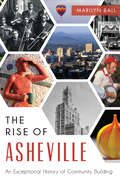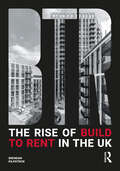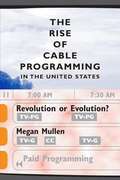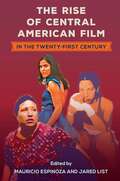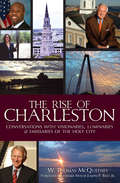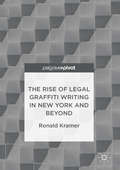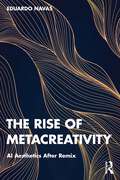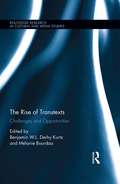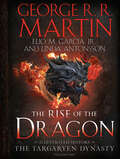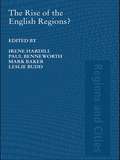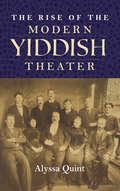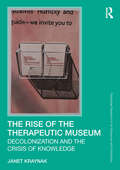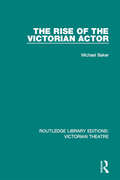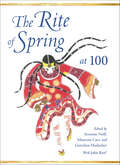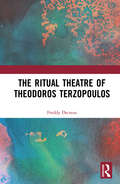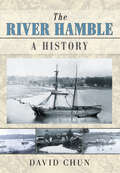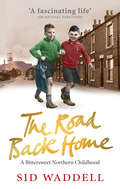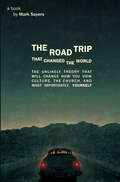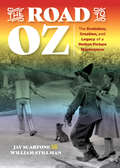- Table View
- List View
The Rise and Rise of Chappell Roan: The Stories Behind the Songs, Tours and Rise of an Icon (Stories Behind The Songs, Tours and Rise of an Icon)
by Katherine St. Asaph Hamza Jahanzeb'Jahanzeb and St. Asaph's song-by-song analysis is illuminating. Sparkly, sassy, but with a strong foundation, much like Roan herself.' - Genevieve Williams, Library JournalWELCOME TO THE PINK PONY CLUBThe SONGS, STORIES, PERFORMANCES, FASHION, and FUTURE of your favourite artist's favourite artist.Step into the glitter-dusted world of Chappell Roan with this ultimate insider's guide.From her early demos as Kalyleigh Amustz to the development of her drag persona and the dazzling stages of The Midwest Princess Tour, this guide chronicles her 10-year journey from small-town dreamer to global queer icon.Delve into the inspiration behind chart-topping hits like 'Good Luck, Babe!', 'Pink Pony Club', and 'HOT TO GO!', along with lesser-known tracks and fan favourites. With iconic photography, stunning illustrations, and rare insights into her collaborations with Dan Nigro, Olivia Rodrigo, and Elton John, this book reveals the trials and triumphs that have fuelled her rise.For fans, dreamers, and anyone who's ever felt like an outsider, this is your backstage pass into the mind of an artist who is fearlessly pushing the boundaries of pop music.CHAPPELL ROAN IS REWRITING THE RULES OF POP STARDOM - THIS IS WHERE IT ALL BEGAN.
The Rise of Academic Architectural Education: The origins and enduring influence of the Académie d’Architecture (Routledge Research in Architectural History)
by Alexander GriffinAcademic architectural education started with the inauguration of the Académie d'Architecture on 3 December 1671 in France. It was the first institution to be devoted solely to the study of architecture, and its school was the first dedicated to the explicit training of architectural students. The Académie was abolished in 1793, during the revolutionary turmoil that besieged France at the end of the eighteenth century, although the architectural educational tradition that arose from it was resurrected with the formation of the École des Beaux-Arts and prevails in the ideologies and activities of schools of architecture throughout the world today. This book traces the previously neglected history of the Académie’s development and its enduring influence on subsequent architectural schools throughout the following centuries to the present day. Providing a valuable context for current discussions in architectural education, The Rise of Academic Architectural Education is a useful resource for students and researchers interested in the history and theory of art and architecture.
The Rise of Asheville: An Exceptional History Of Community Building
by Marilyn BallAs newcomers flocked to Asheville over the last fifty years, they joined with locals to breathe new energy into the city. Sometimes called the Asheville One Thousand, these folks didn't necessarily intend to be entrepreneurs, community organizers and business leaders, but when they saw a challenge, they rose to it. Stone Soup became a gathering place and laid the foundation for Asheville's natural food culture. MANNA Food Bank emerged to help solve hunger. And the River Arts District turned into a vibrant cultural center for upcoming artists. Join author Marilyn Ball as she traces the bonds of community that gave rise to Asheville today.
The Rise of Build to Rent in the UK
by Brendan KilpatrickBuild to Rent (BTR) is a form of residential tenure which first emerged in the United States, where it is known as Multifamily Housing. While it has been a mature asset in the United States for over a decade, it is relatively new to the UK and Ireland. The Rise of Build to Rent in the UK examines how this type of housing can play a key role in streamlining design and construction activity in a forward-facing manner which embraces climate change resilience and digital methods for delivery and management within the circular economy. The book examines the background of traditional UK home-owning and renting from which this new sector emerged, and charts BTR’s momentum swing in 2016 and on-going expansion to the present day, describing the potential of the BTR model in terms of both economic and climate sustainability and evaluating the key ingredients to success. The Rise of Build to Rent in the UK concludes with five highly illustrated UK case studies which evaluate the practical deliverability of real world BTR projects. This book will be of interest to BTR operators and investors, constructors, housing associations, municipal authorities and students of architecture and urban planning.
The Rise of Cable Programming in the United States: Revolution or Evolution?
by Megan MullenIn 1971, the Sloan Commission on Cable Communications likened the ongoing developments in cable television to the first uses of movable type and the invention of the telephone. <P><P>Cable's proponents in the late 1960s and early 1970s hoped it would eventually remedy all the perceived ills of broadcast television, including lowest-common-denominator programming, inability to serve the needs of local audiences, and failure to recognize the needs of cultural minorities. Yet a quarter century after the "blue sky" era, cable television programming closely resembled, and indeed depended upon, broadcast television programming. Whatever happened to the Sloan Commission's "revolution now in sight"?
The Rise of Central American Film in the Twenty-First Century (Reframing Media, Technology, and Culture in Latin/o America)
by Mauricio Espinoza Jared ListHow an overlooked film industry became a cinematic force The first book in English dedicated to the study of Central American film, this volume explores the main trends, genres, and themes that define this emerging industry. The seven nations of the region have seen an unprecedented growth in film production during the twenty-first century with the creation of over 200 feature-length films compared with just one in the 1990s. This volume provides a needed overview of one of the least explored cinemas in the world. In these essays, various scholars of film and cultural studies from around the world provide insights into the continuities and discontinuities between twentieth- and twenty-first-century cinematic production on the Isthmus. They discuss how political, social, and environmental factors, along with new production modes and aesthetics, have led to a corpus of films that delve into issues of the past and present such as postwar memory, failed revolutions, trauma, migration, popular culture, minority populations, and gender disparities. From Salvadoran documentaries to Costa Rican comedies and Panamanian sports films, the movies analyzed here demonstrate the region’s flourishing film industry and the diversity of approaches found within it. The Rise of Central American Film in the Twenty-First Century pays homage to an overlooked cultural phenomenon and shows the importance of regional cinema studies.Contributors: Liz Harvey-Kattou | Daniela Granja Núñez | Carolina Sanabria | Juan Carlos Rodríguez | María Lourdes Cortés | Júlia González de Canales Carcereny | Arno Jacob Argueta | Tomás Arce Mairena | Dr. Mauricio Espinoza | Lilia García Torres | Dr. Jared List | Patricia Arroyo Calderón | Esteban E. Loustaunau | Héctor Fernández L'Hoeste | Juan Pablo Gómez Lacayo | Jennifer Carolina Gómez Menjívar A volume in the series Reframing Media, Technology, and Culture in Latin/o America, edited by Héctor Fernández L’Hoeste and Juan Carlos Rodríguez Publication of this work made possible by a Sustaining the Humanities through the American Rescue Plan grant from the National Endowment for the Humanities.
The Rise of Charleston: Conversations with Visionaries, Luminaries & Emissaries of the Holy City
by W. Thomas McQueeneySince its 1670 founding, Charleston has experienced the devastation of wars, economic hardships and natural disasters. And yet, Charlestonians and their city have prevailed through it all. It is in this current generational surge that the Holy City has experienced meteoric success and taken its place on the world stage. This thematic weave of essays drawn from interviews explores those essential personalities who have lifted Charleston to its new perch as a must-see destination--one that is known as the most welcoming and the most recommended in America. Join engaging local author W. Thomas McQueeney in this updated edition as he relays stories of the 1950s, "60s and "70s through the eyes of those who have witnessed Charleston's evolution to become the charming city it is today.
The Rise of Legal Graffiti Writing in New York and Beyond
by Ronald KramerThis pivot analyzes the historical emergence of legal graffiti and how it has led to a new ethos among writers. Examining how contemporary graffiti writing has been brought into new relationships with major social institutions, it explores the contemporary dynamics between graffiti, society, the art world and social media, paying particular attention to how New York City's political elite has reacted to graffiti. Despite its major structural transformation, officials in New York continue to construe graffiti writing culture as a monolithic, criminal enterprise, a harbinger of economic and civic collapse. This basic paradox - persistent state opposition to legal forms of graffiti that continue to gain social acceptance - is found in many other major cities throughout the globe, especially those that have embraced neoliberal forms of governance. The author accounts for the cultural conflicts that graffiti consistently engenders by theorizing the political and economic advantages that elites secure by endorsing strong 'anti-graffiti' positions.
The Rise of Metacreativity: AI Aesthetics After Remix
by Eduardo NavasThis book brings together history and theory in art and media to examine the effects of artificial intelligence and machine learning in culture, and reflects on the implications of delegating parts of the creative process to AI. In order to understand the complexity of authorship and originality in relation to creativity in contemporary times, Navas combines historical and theoretical premises from different areas of research in the arts, humanities, and social sciences to provide a rich historical and theoretical context that critically reflects on and questions the implications of artificial intelligence and machine learning as an integral part of creative production. As part of this, the book considers how much of postproduction and remix aesthetics in art and media preceded the current rise of metacreativity in relation to artificial intelligence and machine learning, and explores contemporary questions on aesthetics. The book also provides a thorough evaluation of the creative application of systematic approaches to art and media production, and how this in effect percolates across disciplines including art, design, communication, as well as other fields in the humanities and social sciences. An essential read for students and scholars interested in understanding the increasing role of AI and machine learning in contemporary art and media, and their wider role in creative production across culture and society.
The Rise of Transtexts: Challenges and Opportunities (Routledge Research in Cultural and Media Studies)
by Benjamin W.L. Derhy Kurtz Mélanie BourdaaThis volume builds on previous notions of transmedia practices to develop the concept of transtexts, in order to account for both the industrial and user-generated contributions to the cross-media expansion of a story universe. On the one hand exists industrial transmedia texts, produced by supposedly authoritative authors or entities and directed to active audiences in the aim of fostering engagement. On the other hand are fan-produced transmedia texts, primarily intended for fellow members of the fan communities, with the Internet allowing for connections and collaboration between fans. Through both case studies and more general analyses of audience participation and reception, employing the artistic, marketing, textual, industrial, cultural, social, geographical, technological, historical, financial and legal perspectives, this multidisciplinary collection aims to expand our understanding of both transmedia storytelling and fan-produced transmedia texts.
The Rise of the Dragon: An Illustrated History of the Targaryen Dynasty, Volume One (The Targaryen Dynasty: The House of the Dragon)
by George R. Martin Linda Antonsson Elio M. GarcíaNEW YORK TIMES BESTSELLER • This lavish visual history—featuring over 180 all-new illustrations—is a stunning introduction to House Targaryen, the iconic family at the heart of HBO&’s Game of Thrones prequel series, House of the Dragon. For hundreds of years, the Targaryens sat the Iron Throne of Westeros while their dragons ruled the skies. The story of the only family of dragonlords to survive Valyria&’s Doom is a tale of twisty politics, alliances and betrayals, and acts both noble and craven. The Rise of the Dragon chronicles the creation and rise of Targaryen power in Westeros, covering the history first told in George R. R. Martin&’s epic Fire & Blood, from Aegon Targaryen&’s conquest of Westeros through to the infamous Dance of the Dragons—the bloody civil war that nearly undid Targaryen rule for good. Packed with all-new artwork, the Targaryens—and their dragons—come vividly to life in this deluxe reference book. Perfect for fans steeped in the lore of Westeros, as well as those who first meet the Targaryens in the HBO series House of the Dragon, The Rise of the Dragon provides a must-have overview for anyone looking to learn more about the most powerful family in Westeros.
The Rise of the English Regions? (Regions and Cities)
by Mark Baker Paul Benneworth Leslie Budd Irene HardillThis book analyzes devolution as it affects the English Regions, working from the perspective of uneven development, and drawing on the rich tradition of regional geography. Currently, London is the power centre ruling over the other English regions. The first part of the book looks at how this regional structure has arisen, and the theories that can be used to analyze it. The contributors discuss the nature of regional problems and governance, the institutions involved in regional governance and regional approaches to economic development. The second part of the book devotes a chapter to each English region, examining each region’s unique characteristics, and the opportunities created for it by devolution. By looking carefully at the regions, this part of the book sheds light on the question of whether Regional governance benefits the regions, or simply rescales governance to introduce another layer of bureaucracy.
The Rise of the Modern Yiddish Theater: Avrom Goldfaden And The Jewish Stage (Jews Of Eastern Europe Ser.)
by Alyssa QuintJewish Book Award Finalist: &“Turns the fascinating life of Avrom Goldfaden into a multi-dimensional history of the Yiddish theater&’s formative years.&” —Jeffery Veidinger, author of Jewish Public Culture in the Late Russian Empire In this book, Alyssa Quint focuses on the early years of the modern Yiddish theater, from roughly 1876 to 1883, through the works of one of its best-known and most colorful figures, Avrom Goldfaden. Goldfaden (né Goldenfaden, 1840-1908) was one of the first playwrights to stage a commercially viable Yiddish-language theater, first in Romania and then in Russia. Goldfaden&’s work was rapidly disseminated in print and his plays were performed frequently for Jewish audiences. Sholem Aleichem considered him as a forger of a new language that &“breathed the European spirit into our old jargon.&” Quint uses Goldfaden&’s theatrical works as a way to understand the social life of Jewish theater in Imperial Russia. Through a study of his libretti, she looks at the experiences of Russian Jewish actors, male and female, to explore connections between culture as artistic production and culture in the sense of broader social structures. Quint explores how Jewish actors who played Goldfaden&’s work on stage absorbed the theater into their everyday lives. Goldfaden&’s theater gives a rich view into the conduct, ideology, religion, and politics of Jews during an important moment in the history of late Imperial Russia.
The Rise of the Neighbourhood in Canada, 1880s–2020s
by Richard HarrisNeighbourhoods matter now more than ever before. They sustain fewer social connections, but in an era of great social inequality and high levels of immigration, they have become vital as places for homeowner investment and educational opportunity for children. The Rise of the Neighbourhood in Canada, 1880s–2020s traces the changing character and significance of Canadian urban neighbourhoods, city and suburban, since the 1880s. The book highlights patterns in neighbourhood life, particularly noticeable in larger urban areas, which are especially important for the least mobile people: workers, lower income households, immigrants, women, children, and the elderly. It explores how the physical and social characteristics of neighbourhoods affect public health, crime rates, social capital, and job opportunities while shaping the lifelong prospects of children. Analysing long-term trends, the book examines the importance of communications technology in the context of rising inequality and immigration. It shows how, as homeownership rose, neighbourhoods became vital settings for investment, increasingly financialized, reducing affordability. Using examples from all types of neighbourhoods in cities small and large, from St. John’s through Montreal and Winnipeg to Victoria, The Rise of the Neighbourhood in Canada argues that the current prominence of neighbourhoods will persist.
The Rise of the Therapeutic Museum: Decolonization and the Crisis of Knowledge (Routledge Research in Art Museums and Exhibitions)
by Janet KraynakThis book considers how and why respite rooms, emotional support brochures, well-being guides, psychological consultants, and care days are becoming common features in the museum of art.Kraynak poses and answers this question, arguing that under its rightful ambition to decolonize––i.e., to rectify past and present inequalities–– the museum of the Global North is gradually replacing a commitment to knowledge, teaching, and learning with a focus upon care, healing, and well-being (the “therapeutic”). While this transformation might appear, on the surface, benign, culturally familiar, and politically desirable, the author counters these presumptions, probing the history and implications of “the therapeutic museum.” Here, curatorial attention shifts away from the art on view and onto the spectator, whom the museum imagines as a precarious psychological subject, and primary source of meaning. External forces–– new forms of knowledge, encounters with difficulty, even an engagement with art––are treated as a potential threat. As a result, the therapeutic museum not only encourages thebeholder to turn inward, but in so doing deflects attention from or scrutiny of its own practices and systems that perpetuate inequality. Among these are the ongoing legacies colonialism’s epistemic violence, which elevated the knowledge and aesthetic traditions of the Global North while suppressing those of the Global South. In contrast, the book proposes a “pluriversal” (versus universal) museum that maintains the political necessity of knowledge and views pedagogy as a path to emancipation. Emphasizing epistemic justice and the moral right to learn during a time when such freedoms are increasingly under attack, the book makes a powerful case for questioning rather than romanticizing the therapeutic museum, which it ultimately reveals to reinforce rather than challenge dominant power.This is an important intervention that is essential reading for researchers and scholars in Art History, Visual Studies, Museum Studies, and Cultural Studies.
The Rise of the Victorian Actor (Routledge Library Editions: Victorian Theatre #1)
by Michael BakerOriginally published in 1978. Between 1830 and 1890 the English theatre became recognisably modern. Standards of acting and presentation improved immeasurably, new playwrights emerged, theatres became more comfortable and more intimate and playgoing became a national pastime with all classes. The actor’s status rose accordingly. In 1830 he had been little better than a social outcast; by 1880 he had become a member of a skilled, relatively well-paid and respected profession which was attracting new recruits in unprecedented numbers. This is a social history of Victorian actors which seeks to show how wider social attitudes and developments affected the changing status of acting as a profession. Thus the stage’s relationship with the professional world and the other arts is dealt with and is followed by an assessment of the moral and religious background which played so decisive a part in contemporary attitudes to actors. The position of actresses in particular is given special consideration. Many non-theatrical sources are used here and there is a survey of salaries and working conditions in the theatre to show how the rising social status of the actor was matched by changes in his theatrical standing. A novel area of study is covered in tracing the changing social composition of the acting profession over the period and in exploring the case-histories of three generations of performers.
The Rite of Spring at 100
by Stephen Walsh Gretchen Horlacher John Reef Maureen Carr Severine NeffWhen Igor Stravinsky's ballet Le Sacre du printemps (The Rite of Spring) premiered during the 1913 Paris season of Sergei Diaghilev's Ballets Russes, its avant-garde music and jarring choreography scandalized audiences. Today it is considered one of the most influential musical works of the twentieth century. In this volume, the ballet finally receives the full critical attention it deserves, as distinguished music and dance scholars discuss the meaning of the work and its far-reaching influence on world music, performance, and culture. Essays explore four key facets of the ballet: its choreography and movement; the cultural and historical contexts of its performance and reception in France; its structure and use of innovative rhythmic and tonal features; and the reception of the work in Russian music history and theory. This version also includes audio and visual supplements designed to enhance understanding of this classic piece.
The Rite of Spring at 100 (Musical Meaning and Interpretation)
by John ReefWhen Igor Stravinsky's ballet Le Sacre du printemps (The Rite of Spring) premiered during the 1913 Paris season of Sergei Diaghilev's Ballets Russes, its avant-garde music and jarring choreography scandalized audiences. Today it is considered one of the most influential musical works of the twentieth century. In this volume, the ballet finally receives the full critical attention it deserves, as distinguished music and dance scholars discuss the meaning of the work and its far-reaching influence on world music, performance, and culture. Essays explore four key facets of the ballet: its choreography and movement; the cultural and historical contexts of its performance and reception in France; its structure and use of innovative rhythmic and tonal features; and the reception of the work in Russian music history and theory.
The Ritual Theatre of Theodoros Terzopoulos
by Freddy DecreusThe Ritual Theatre of Theodoros Terzopoulos outlines the story of the Athenian-based Attis Theatre and the way its founder and director, Theodoros Terzopoulos, introduced bio-energetic presences of the body on the stage, in an attempt to redefine and reappraise what it means today not only to have a body, but to fully be a body. Terzopoulos created a very specific attitude towards life and death, and it is this broad perspective on energy and consciousness that makes his work so appealing both to a general public and to students of arts, theatre and drama. Freddy Decreus’ study charts the career of Greece’s most acclaimed theatre director and provides a spiritual and philosophic answer in times where former Western meta-narratives have failed.
The River Hamble: A History
by David ChunThe Hamble rises at Bishop’s Waltham in Hampshire and flows into Southampton Water. It is a relatively small river but it has an interesting and varied history. Above Botley, the Hamble powered a number of mills, and in the 17th century plans to make that section navigable were contemplated. The tidal river below Botley has served as an important local conduit for the carriage of goods and commodities, particularly timber, underwood and fl our, and a number of industries, including fishing and salt production, have flourished on its banks over the centuries. King Henry V’s fleet was stationed on the river and in the 18th and 19th centuries it was an important location for naval shipbuilding, not least because of the ample supplies of timber to be found in the valley. One of Nelson’s flagships, HMS Elephant, was built there in the 1800s. The proximity of Southampton and Portsmouth meant the river was militarily important during the Second World War as well as in earlier conflicts. It also boasts a number of literary associations, particularly that of William Cobbett, who lived and farmed at Botley for a number of years at the beginning of the 19th century. The river has been a popular centre for yachting for over 100 years and there are a number of boatyards and marinas along its lower reaches today. However, despite this and other commercial development, the river is still prized for its natural beauty, and large sections are protected for their ecological and conservation value. Drawing on printed and archival sources, and with a wealth of illustrations, this book traces the river from its source to the sea.
The Road Back Home: A Northern Childhood
by Sid Waddell'I had not lived in the former pit village of Lynemouth since 1961 but the winding road north from Newcastle will always be the same nostalgic highway, each twist charged with vivid memories and powerful emotions...'So begins a story full of wonderful humour, emotional candour and hardy tales of tough times - a quietly epic family saga set amid the pit villages of the North East . It stretches from the 1920s, before Sid's parents had even met, to the final closing of the mine and his mother's death in 1999.Sid paints a picture of a colourful, tight knit community full of good times and hard work, god-fearing women and hard-drinking men. Always dominating the skyline is Auld Betty, the pit head that took the men away each day and, with a prayer, brought them back each evening. Amongst the unforgettable cast of his extended family and friends, we follow the Waddells' attempts to stay afloat and provide a better future and possible escape for youngsters like Sid.
The Road Movie: In Search of Meaning (Short Cuts)
by Neil ArcherThough often seen as one of America's native cinematic genres, the road movie has lent itself to diverse international contexts and inspired a host of filmmakers. As analyzed in this study, from its most familiar origins in Hollywood the road movie has become a global film practice, whether as a vehicle for exploring the relationship between various national contexts and American cinema, as a means of narrating different national and continental histories, or as a form of individual filmmaking expression. Beginning with key films from Depression-era Hollywood and the New Hollywood of the late 1960s and then considering its wider effect on world cinemas, this volume maps the development and adaptability of an enduring genre, studying iconic films along the way.
The Road Trip that Changed the World: The Unlikely Theory that will Change How You View Culture, the Church, and, Most Importantly, Yourself
by Mark SayersCan&’t find no satisfaction? There&’s no shortage of prescriptions for restlessness out there: Seek adventure. Live your life. Don&’t hold back.Sound familiar?The Road Trip that Changed the World is a book challenging the contemporary conviction that personal freedom and self-fulfillment are the highest good. Like the characters in a Jack Kerouac novel, we&’ve dirtied the dream of white picket fences with exhaust fumes. The new dream is the open road—and freedom. Yet we still desire the solace of faith. We like the concept of the sacred, but unwittingly subscribe to secularized, westernized spirituality. We&’re convinced that there is a deeper plot to this thing called life, yet watered-down, therapeutic forms of religion are all we choose to swallow, and our personal story trumps any larger narrative.This is the non-committal culture of the road. Though driving on freely, we have forgotten where we&’re headed. Jesus said His road is narrow. He wasn&’t some aimless nomad. He had more than just a half tank of gas—He had passion, objectives, and a destination. Do you?
The Road Trip that Changed the World: The Unlikely Theory that will Change How You View Culture, the Church, and, Most Importantly, Yourself
by Mark SayersCan&’t find no satisfaction? There&’s no shortage of prescriptions for restlessness out there: Seek adventure. Live your life. Don&’t hold back.Sound familiar?The Road Trip that Changed the World is a book challenging the contemporary conviction that personal freedom and self-fulfillment are the highest good. Like the characters in a Jack Kerouac novel, we&’ve dirtied the dream of white picket fences with exhaust fumes. The new dream is the open road—and freedom. Yet we still desire the solace of faith. We like the concept of the sacred, but unwittingly subscribe to secularized, westernized spirituality. We&’re convinced that there is a deeper plot to this thing called life, yet watered-down, therapeutic forms of religion are all we choose to swallow, and our personal story trumps any larger narrative.This is the non-committal culture of the road. Though driving on freely, we have forgotten where we&’re headed. Jesus said His road is narrow. He wasn&’t some aimless nomad. He had more than just a half tank of gas—He had passion, objectives, and a destination. Do you?
The Road to Oz: The Evolution, Creation, and Legacy of a Motion Picture Masterpiece
by William Stillman Jay ScarfoneThe Road to Oz is a complete retelling of how The Wizard of Oz was influenced and created, and attained its iconic status. The new volume by Jay Scarfone and William Stillman will reflect recent research and much more through newly discovered period interviews, media resources of the era, transcriptions and unique contemporary interviews with those who were there. Additionally, never-before-published imagery accompanies the text. In its truth and candor, this new historical contribution is ideal to tie-in with the 2018-19 80th anniversary of the 1939 movie.Tantalizing highlights of the text include:· A thorough synopsis of L. Frank Baum&’s The Wonderful Wizard of Oz (1900) and the script, inspired by the book, of the 1903 Broadway musical-comedy extravaganza.· An overview of the plots of prior silent film adaptations of Oz and how they influenced the M-G-M film.· An analysis of newly-discovered audio transcriptions of Wizard of Oz radio programs from 1931-32 and 1937-38—all of which were previously unknown.· A complete accounting of Sam Goldwyn&’s proposed (and aborted) 1934 Technicolor musical version of Oz starring Eddie Cantor (including commentary from Cantor&’s sole surviving child).· A thorough analysis of the October 10, 1938 M-G-M shooting script (provided by descendants of comedian and Cowardly Lion actor Bert Lahr) that predates the beginning of production by seventy-two hours.· Startling revelations about the operetta that seemingly inspired &“Over the Rainbow.&”· Judy Garland&’s trials and tribulations with the studio, including the threat that M-G-M was grooming a sound-alike who tested for Oz.· The supporting player who was cast in two roles in Oz&’s fantasy sequence—the second role revealed for the first time in Scarfone and Stillman&’s text.· The Munchkin midgets&’ pre-1939 Wizard of Oz connection.· Oz&’s film editor with a direct connection to Walt Disney and Snow White.· Studio nepotism, favoritism and politics at the height of Hollywood&’s golden age on the making of the world&’s most famous film.&“The Road to Oz not only delivers exciting, previously unpublished information and insight, but does so in an extremely well-cited format. This is absolutely a must-have for any Oz fan or film historian.&” —Sean Barrett, theatrical/film producer and artistic director, Land of Oz, North Carolina &“A new and wonderful book penned by the foremost Oz movie history authors. This is a must-read for all old and new Oz fans worldwide.&” —Roger S. Baum, author of Dorothy of Oz (on which the film Legends of Oz: Dorothy&’s Return is based) and great-grandson of L. Frank Baum&“Numerous books have celebrated the fan appeal of MGM&’s Wizard of Oz, but there&’s far more to this story than nostalgia. Scarfone and Stillman delve deep into the history of this landmark film, exploring its place in the pantheon of classic fantasy films, as well as fascinating details of production. The Road to Oz is an important addition to the film-history bookshelf.&” —J.B. Kaufman, film historian and author of The Fairest One of All: The Making of Walt Disney&’s Snow White and the Seven Dwarfs&“The Road to Oz is a gamechanger in the world of motion picture history books. Long considered the leading authorities on the making of The Wizard of Oz, Scarfone and Stillman have crafted decades of extensive research into a new and unparalleled historical recalling of the classic film.&” —Randy L. Schmidt, editor of Judy Garland on Judy Garland: Interviews and Encounters and author of Little Girl Blue: The Life of Karen Carpenter


